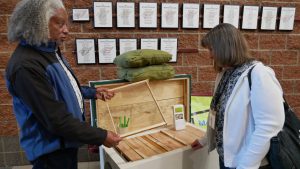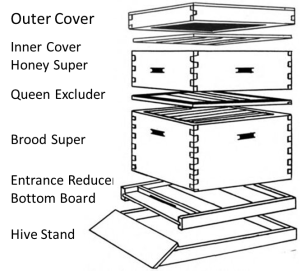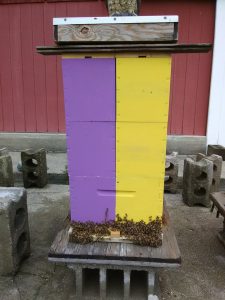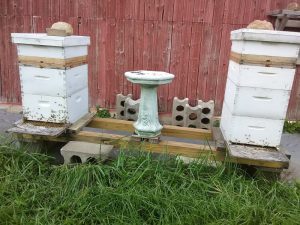Beginner Beekeeping Basics
By: Richard Wahl

Loren Tate and his top bar hive at the 2022 Fall MBA Conference (photo by Joan Mandell)
Before I delve into the basics, let me share a bit of background as to how I chose the topic for this issue. In the November issue of Bee Culture Magazine I wrote about the advantages of taking a class, joining a club or doing extensive reading before acquiring your first beehive (That article on Resources for the New Beekeeper can also be found on the Bee Culture website: https://beeculture.com/off-the-wahl-beekeeping-2/). I understand that the costs involved or the time commitment required for these activities may be an inhibiting factor for some individuals with young families or competing work schedules. But there is another possibility which requires only a day or two and a minimal cost. That is to attend an annual or semi-annual beekeeping conference, convention or meeting. Most state or country beekeeping associations hold annual or semi-annual get-togethers of this type lasting for one or two days. Simply type your state or country name into an internet search engine followed by “beekeepers” and more than likely several organization or association events related to beekeeping will show up. Searching Michigan Beekeeper’s Association (MBA) will take you directly to the 2022 Fall Conference Review. This coming year’s MBA Spring conference is scheduled for March 11, 2023.

Stephanie Slater and Chris Beck judging honey at the 2022 Fall MBA Conference (photo by Joan Mandell)
Shortly after I began writing for this column a year ago, I was asked to be a speaker at the MBA Spring conference. Although I had heard about such events, I had yet to attend such a conference and was uninitiated on what such an experience would entail. Given the latitude to determine my presentation topic made acceptance of the invitation a bit easier as I could use my previously prepared topic from two years earlier where I taught a small beginner class just before the COVID lock downs. That coupled with the fact that I had taught high school college prep mathematics for sixteen years made the option of public speaking a bit less daunting. With some trepidation I accepted the invitation. My topic was aimed at the new beekeeper or the individual thinking about starting out as a beekeeper, summarized and re-tailored a bit farther on for this article. Most beekeeping association conferences will have at least one track of speakers throughout the day and may have as many as three or four. Often these tracks are split toward the level of the beekeeper audience experience, be those just getting started, those with a few years of experience, or possibly directed topics such as queen rearing or commercial beekeeping challenges. In addition to the lecture tracks there is often a room set up where vendors can bring in their beekeeping wooden ware, bee related or other hive products for sale. At Fall conferences, it is not unusual to find a honey and/or wax judging contest.
I found all levels of experience and expertise to be present at last Spring’s MBA conference. I was expecting maybe thirty to forty participants for my “Getting Started and Sustaining Your Hives” topic and was surprised as a first time speaker to draw an audience of near one hundred interested newer beekeepers, representing about one-quarter of those in attendance.
Back to Basics to Consider
Before jumping into the art of beekeeping one needs to consider the time commitment and costs involved. When asked by the casual honey purchaser or interested party, “What does it take to be a beekeeper?”, my short answer is that it is animal husbandry, only with an insect. Just as your pet cat, dog, pony or aquarium fish have food, water and shelter needs along with watching out for pests and diseases, so do the bees. Far too many first time beekeepers think a box can be set out, the bees fend for themselves and a little honey can be collected in the late Summer or Fall. The concept that feral bees survived in the wild for thousands of years without human intervention is no longer the norm. Due to invasive pests such as varroa mites and hive beetles along with the myriad of agricultural chemical use that continues to challenge survival of any insects, the existence of feral colonies is becoming more and more non-existent in many parts of our chemically dependent world. Although a beehive does not require daily attention for water and food needs as other pets would, there are still periods in the Spring and Fall where more concentrated efforts are required for inspections or honey collection. It is highly recommended that the new beekeeper make a good inspection every two to three weeks through the late Spring, Summer and Fall to assess the state of their hives and catch any abnormalities before they become lethal to the hive. As experience is gained, fewer deep inspections, moving frames about, are required. During mid-Summer months, one can get a good idea how well the hive is doing by watching the bees coming and going at the entrance. Weather conditions will often dictate optimal hive inspection times. Time of day, frontal passage, temperature, rainfall, wind and humidity should all be taken into consideration when opening a hive. The bees work very hard to keep their micro-climate inside the hive at an optimal state and when the hive is opened and frames moved about these optimal conditions are upset. It may take days after a long or thorough hive inspection for the bees to return things to their optimal condition. If the only available inspection times are weekends due to a beekeeper’s work or travel schedule and those weekends are coincidentally rainy, windy or consistently have a frontal system moving through, optimal inspection times may be difficult to achieve. Several years ago, I assisted a new beekeeper whose work schedule only allowed for hive inspections on weekends. Unfortunately, a number of less than ideal weather conditions precluded thorough hive inspections on a number of subsequent weekends resulting in an unnoticed queen loss that could have been corrected sooner if it had been caught in earlier midweek better weather conditions. (I see a potential future article here on the effects of weather in beekeeping.)
Research Potential Costs

Hive components with a single deep and honey super.
Startup costs are another factor to be considered. A basic hive kit that includes a bottom board, entrance reducer, ten frame deep box (called a super) with ten frames and foundation, an inner cover and a telescoping outer cover would be the minimal hive requirement. Toss in a few more essentials such as a smoker, good hive tool, bee brush and bee suit and you may be set to order your first bee package or nucleus hive. Prices on all items can vary dependent on mail order from a bee catalogue or if there is a local supplier where a pickup can be made to avoid shipping fees. But then as the eternal optimist you need to consider that your hive will continue to expand and your bees will soon need more room, which will demand a second deep with the associated frames and foundations. As Summer progresses and your bees bring in more pollen and nectar, a honey super or two with even more frames will need to be added.
If you are placing hives where cattle or large predators co-exist, there may be a need for fencing, possibly electrified. The point is to do some research on expected costs before jumping into the beekeeping hobby. Early Spring and Summer feeding can aid greatly in getting that first hive off to a good start. Once the bees become active after that first Spring pollen collection, a pollen patty is a good idea for a boost and good early brood development. Adding a one to one sugar syrup mix will serve as a nectar substitute if your nectar flow lags after that first Spring pollen burst, as it does in my area, minimally adding to additional start-up costs. My maples pop in early March for a day or two with a month lag before the dandelions provide any sort of nectar flow. In the Southeast Michigan Beekeeper Association (SEMBA) class that my partner and I taught this past year, we recommended the purchase of two nucs (nucleus hives which usually come with a mated, laying queen and five frames, at least three with that queen’s brood) to start two hives. The purpose of nucs is that they provide about a month head start over a package purchase and two hives allow for a comparison.

A ten frame deep split in two sections with two story, four frame nucs above that. Successfully came through Winter with both entrances facing forward.
This past Summer, I was asked to assist two different first year beekeepers who had some concerns about their hives. Each new beekeeper had two hives and one beekeeper’s set was doing well. We even started a third nuc hive from his strongest hive during my visit. The other beekeeper had a legitimate concern as one hive did not have the same activity as the other. Come to find out the weaker hive had lost its queen and we were able to set an egg/larva/brood frame from the stronger hive in it. A later report indicated the weaker hive had produced a new queen and that both hives were doing well. Had there only been the one weaker hive, this discrepancy may not have been discovered in time to take remedial action, and no available second hive would have meant ordering and purchasing a new queen.
Location, Location, Location
As the saying goes, location can be a great determining factor as to the success of the beginning beekeeper. There are numerous considerations to make when siting a hive. Ideally, a spot for hives should be chosen that is a bit elevated off the ground and gets early morning sun with the bottom entrance facing east or south. Leave three or four feet behind the hives to make working in them easier as working in the front entrance bee path is more irritating to the bees. Any natural or constructed protection from north and west Winter winds is certainly a plus, particularly in unpredictable northern climates. Looking into any local ordinance requirements may preclude confrontation with governing officials. Letting neighbors in on your new beekeeping endeavor and offering to share a jar or two of your future honey crop can go a long way to appease neighbor’s concerns. Just a quick explanation to neighbors as to what to do if they encounter a bee can create better peace of mind. I find that honey bees are not prone to sting unless they feel threatened as you deep inspect a hive or pinch them in some way. Their normal action when out in the open, or even as you get closer to the hive, is to buzz around your head and even do a head bump or two before they sting. If you walk quickly away from the hive location they may follow you for a bit, but I find they will often abandon the chase as you get farther away from the hive. This seems to work particularly well if you walk under low tree branches. I have succeeded with this quick walk away action many times, but naturally there is always the exception. Once, several hundred feet away from my hives, days past any inspection activity, I encountered a bee that was obviously on a direct path back to the hive. Without provocation or preemptive notice the bee made a direct hit and sting on my forehead. Accepting the fact that you may get stung is another consideration when determining if beekeeping is for you. Of course the Africanized bees, now more prevalent in the southern U.S. states, require much less stimulation to get agitated and reach the attacking, stinging state.

Hives with a birdbath water source.
An additional consideration for hive placement is to have a nearby water source. Bees seem to love the chemical content of a neighbor’s swimming pool if nearby. My bees avoid my very hard well water or even distilled water if provided and prefer my neighbor’s pond or a nearby drainage ditch. Another consideration is the ease of access to the location of your hives. Hauling a thirty to forty pound honey super any short distance can easily put a strain on one’s back. After getting my truck stuck in a relative’s farm lane that had several drainage ditches, I gave up on the placement of several hives on that end of the lane property that had a natural overgrown, brushy protected spot otherwise ideal for a hive.
Mentors, Classes, Clubs and Books
My November article, as noted in the opening paragraph, covered classes, clubs and books. An equally optimal option is to find a person willing to be your mentor. An experienced beekeeper even with only a few more year’s experience can go a long way to get a new beekeeper off to a good start. The perfect place to meet these experienced beekeepers is to attend a convention or conference, join a club or take a class which brings us full circle back to the opening of this article. This year’s MBA conference will be held in Lansing on March 11, 2023. Find more information as it develops at: www.canr.msu.edu/events/michigan-beekeepers-association-conference. The new beekeeper’s success will only be enhanced by seeking out answers and having a willingness to learn. I find nearly all persons in this intriguing insect management endeavor to be pleasant, conversant people willing to share their experiences. If you have been hesitant to jump into the hobby of beekeeping, give the aforementioned ideas some thought and if your situation is amenable to the conditions stated above give beekeeping management a try. I do not think you will be disappointed.









